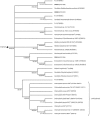Molecular evidence for association of chlamydiales bacteria with epitheliocystis in leafy seadragon (Phycodurus eques), silver perch (Bidyanus bidyanus), and barramundi (Lates calcarifer)
- PMID: 16391055
- PMCID: PMC1352285
- DOI: 10.1128/AEM.72.1.284-290.2006
Molecular evidence for association of chlamydiales bacteria with epitheliocystis in leafy seadragon (Phycodurus eques), silver perch (Bidyanus bidyanus), and barramundi (Lates calcarifer)
Abstract
Epitheliocystis in leafy seadragon (Phycodurus eques), silver perch (Bidyanus bidyanus), and barramundi (Lates calcarifer), previously associated with chlamydial bacterial infection using ultrastructural analysis, was further investigated by using molecular and immunocytochemical methods. Morphologically, all three species showed epitheliocystis cysts in the gills, and barramundi also showed lymphocystis cysts in the skin. From gill cysts of all three species and from skin cysts of barramundi 16S rRNA gene fragments were amplified by PCR and sequenced, which clustered by phylogenetic analysis together with other chlamydia-like organisms in the order Chlamydiales in a lineage separate from the family Chlamydiaceae. By using in situ RNA hybridization, 16S rRNA Chlamydiales-specific sequences were detected in gill cysts of silver perch and in gill and skin cysts of barramundi. By applying immunocytochemistry, chlamydial antigens (lipopolysaccharide and/or membrane protein) were detected in gill cysts of leafy seadragon and in gill and skin cysts of barramundi, but not in gill cysts of silver perch. In conclusion, this is the first time epitheliocystis agents of leafy seadragon, silver perch and barramundi have been undoubtedly identified as belonging to bacteria of the order Chlamydiales by molecular methods. In addition, the results suggested that lymphocystis cysts, known to be caused by iridovirus infection, could be coinfected with the epitheliocystis agent.
Figures


References
-
- Anderson, I. G., and H. C. Prior. 1992. Subclinical epitheliocystis in barramundi, Lates calcarifer, reared in sea cages. Aust. Vet. J. 69:226-227. - PubMed
-
- Bradley, T. M., C. E. Newcomer, and K. O. Maxwell. 1988. Epitheliocystis associated with massive mortalities of cultured lake trout Salvelinus namaycush. Dis. Aquat. Org. 4:9-17.
-
- Crespo, S., C. Zarza, F. Padros, and M. Marin de Mateo. 1999. Epitheliocystis agents in sea bream Sparus aurata: morphological evidence for two distinct chlamydia-like developmental cycles. Dis. Aquat. Org. 37:61-72. - PubMed
-
- Devereaux, L. N., A. Polkinghorne, A. Meijer, and P. Timms. 2003. Molecular evidence for novel chlamydial infections in the koala (Phascolarctos cinereus). Syst. Appl. Microbiol. 26:245-253. - PubMed
MeSH terms
Substances
Associated data
- Actions
- Actions
- Actions
- Actions
- Actions
- Actions
- Actions
- Actions
- Actions
- Actions
- Actions
- Actions
- Actions
- Actions
- Actions
- Actions
- Actions
- Actions
- Actions
- Actions
- Actions
- Actions
- Actions
- Actions
- Actions
- Actions
- Actions
- Actions
- Actions
- Actions
- Actions
- Actions
- Actions
- Actions
- Actions
- Actions
- Actions
- Actions
- Actions
- Actions
- Actions
- Actions
- Actions
- Actions
- Actions
- Actions
- Actions
- Actions
- Actions
- Actions
- Actions
- Actions
- Actions
- Actions
- Actions
- Actions
- Actions
- Actions
- Actions
- Actions
- Actions
- Actions
- Actions
- Actions
- Actions
- Actions
- Actions
- Actions
- Actions
- Actions
- Actions
- Actions
- Actions
- Actions
- Actions
- Actions
- Actions
- Actions
- Actions
LinkOut - more resources
Full Text Sources

